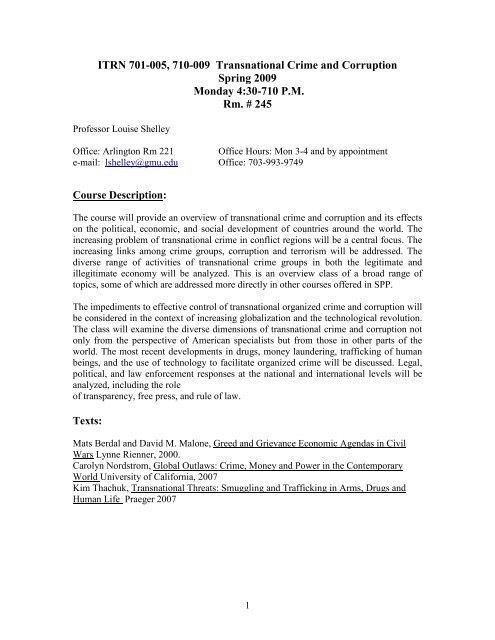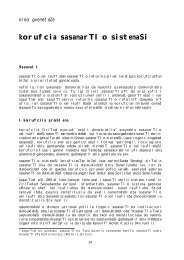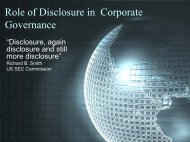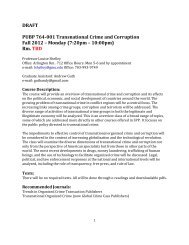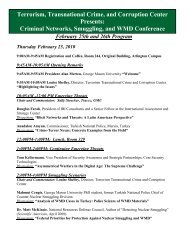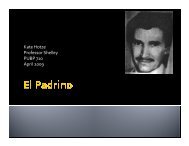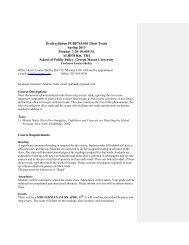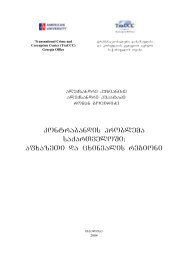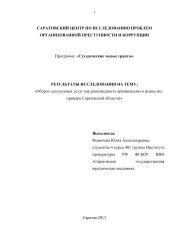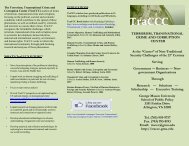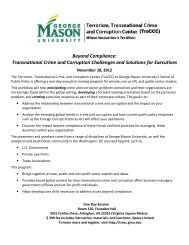syllabus - Terrorism, Transnational Crime and Corruption Center
syllabus - Terrorism, Transnational Crime and Corruption Center
syllabus - Terrorism, Transnational Crime and Corruption Center
You also want an ePaper? Increase the reach of your titles
YUMPU automatically turns print PDFs into web optimized ePapers that Google loves.
ITRN 701-005, 710-009 <strong>Transnational</strong> <strong>Crime</strong> <strong>and</strong> <strong>Corruption</strong><br />
Spring 2009<br />
Monday 4:30-710 P.M.<br />
Rm. # 245<br />
Professor Louise Shelley<br />
Office: Arlington Rm 221 Office Hours: Mon 3-4 <strong>and</strong> by appointment<br />
e-mail: lshelley@gmu.edu Office: 703-993-9749<br />
Course Description:<br />
The course will provide an overview of transnational crime <strong>and</strong> corruption <strong>and</strong> its effects<br />
on the political, economic, <strong>and</strong> social development of countries around the world. The<br />
increasing problem of transnational crime in conflict regions will be a central focus. The<br />
increasing links among crime groups, corruption <strong>and</strong> terrorism will be addressed. The<br />
diverse range of activities of transnational crime groups in both the legitimate <strong>and</strong><br />
illegitimate economy will be analyzed. This is an overview class of a broad range of<br />
topics, some of which are addressed more directly in other courses offered in SPP.<br />
The impediments to effective control of transnational organized crime <strong>and</strong> corruption will<br />
be considered in the context of increasing globalization <strong>and</strong> the technological revolution.<br />
The class will examine the diverse dimensions of transnational crime <strong>and</strong> corruption not<br />
only from the perspective of American specialists but from those in other parts of the<br />
world. The most recent developments in drugs, money laundering, trafficking of human<br />
beings, <strong>and</strong> the use of technology to facilitate organized crime will be discussed. Legal,<br />
political, <strong>and</strong> law enforcement responses at the national <strong>and</strong> international levels will be<br />
analyzed, including the role<br />
of transparency, free press, <strong>and</strong> rule of law.<br />
Texts:<br />
Mats Berdal <strong>and</strong> David M. Malone, Greed <strong>and</strong> Grievance Economic Agendas in Civil<br />
Wars Lynne Rienner, 2000.<br />
Carolyn Nordstrom, Global Outlaws: <strong>Crime</strong>, Money <strong>and</strong> Power in the Contemporary<br />
World University of California, 2007<br />
Kim Thachuk, <strong>Transnational</strong> Threats: Smuggling <strong>and</strong> Trafficking in Arms, Drugs <strong>and</strong><br />
Human Life Praeger 2007<br />
1
Recommended Journals:<br />
Trends in Organized <strong>Crime</strong> Transaction Publishers<br />
<strong>Transnational</strong> Organized <strong>Crime</strong> (now Global <strong>Crime</strong> Cass Publishers)<br />
Recommended Websites:<br />
See Links <strong>and</strong> publications section of TraCCC website (www.policy-traccc.gmu.edu)<br />
http://www.organized-crime.de/ (Klaus von Lampe’s website)<br />
http://www.ncjrs.org/index.html (National Criminal Justice Reference Service, many<br />
publications on transnational crime)<br />
http://www.yorku.ca/nathanson/default.htm (see links <strong>and</strong> publication sections)<br />
www.ciroc.org ( see newsletters <strong>and</strong> past isues of this Dutch based group)<br />
www.unodc.org (United Nations Office on Drugs <strong>and</strong> <strong>Crime</strong>)<br />
http://www.iom.int/jahia/Jahia/pid/748 (counter-trafficking part of International<br />
Organization for Migration website)<br />
http://www.state.gov/p/inl/rls/nrcrpt/ US State Department narcotics reports<br />
http://www.wola.org/index.php?option=com_content&task=viewp&id=588&Itemid=2<br />
(organized crime in Latin America, WOLA website)<br />
http://www.asiapacificms.com/articles/ (Bertil Lintner’s writings on organized crime in<br />
Asia)<br />
E-Reserves: Instructions on how to access<br />
• Go to http://library.gmu.edu<br />
• Click on “E-Reserves”<br />
• Click on “search electronic reserves”<br />
• Select a course: “PUBP710 section 009”<br />
• Select an instructor: “Shelley, Louise”<br />
• Enter the password: “corruption”<br />
• Click on “Submit”<br />
Course Requirements:<br />
Reading<br />
A significant amount of reading is required for the course. Students who fall behind will<br />
have a difficult time catching up. Students are expected to do the assigned reading in<br />
advance of the class. The class will presume knowledge of the readings assigned for that<br />
week. Students are expected to keep up with news on transnational crime that is reported<br />
in newspapers <strong>and</strong> on-line sources <strong>and</strong> to discuss recent developments in class each week.<br />
Attendance<br />
Students will be expected to attend the whole class. Attendance will be taken. Your grade<br />
will be reduced for unexplained <strong>and</strong> unexcused absences. Please inform me if you will be<br />
absent from a class.<br />
Exams<br />
2
There will be a mid-term exam on March 30 th . It will combine short identifications <strong>and</strong><br />
long essays. The exam will draw on the readings, class lectures, <strong>and</strong> discussions.<br />
Class Project 20%: Written <strong>and</strong> Oral Presentations, presentations will be chosen by the<br />
student in coordination with the instructor. The presentations to the class will begin on<br />
March 16 th .<br />
The student can do either of the below:<br />
A) Map an international criminal network. Show the commodities the criminals’ use, the<br />
routes they take, their historical development <strong>and</strong> the other crime groups with whom they<br />
are most likely to work. Please show how these relationships have changed over time.<br />
Presentation should be a powerpoint with a bibliography that will be h<strong>and</strong>ed in the day of<br />
the presentation. (20%)<br />
B) Research a major investigation of a transnational crime case or a prosecuted crime<br />
network. Examine the evidence that has been used to address the group <strong>and</strong> what has<br />
been learned about its criminal activities <strong>and</strong> money laundering from the investigation.<br />
This could be a trafficking group, a drug organization or a diverse smuggling<br />
organization. It can look at a prosecution that has occurred in the U.S. or abroad.<br />
Term Paper Due May 11th Length 20-25 pages, st<strong>and</strong>ard reference format<br />
The topic will be chosen after consultation with the instructor. It can use insights that are<br />
obtained from the oral presentation. It should discuss a topic related to transnational<br />
crime <strong>and</strong> should develop a bibliography of diverse sources. Topics might include such<br />
topics as: The rise of drug trafficking in Afghanistan, Examining the role of natural<br />
resources in perpetuating conflict, How do crime groups negatively affect the<br />
environment. You can choose to focus on a particular area of criminal activity, a region<br />
of the world or a strategy or set of strategies used to address the problem.<br />
Grading:<br />
Students will be graded according to the following criteria:<br />
Class attendance <strong>and</strong> participation 20%<br />
Class Project 20%<br />
Mid-Term Exam 25%<br />
Term Paper 35%<br />
Plagiarism:<br />
Plagiarism is representing or submitting someone else's language or ideas as your own.<br />
Plagiarism is strictly prohibited by the University <strong>and</strong> will lead to disciplinary action.<br />
You must write your own papers. Identify, with quotation marks <strong>and</strong> footnotes, direct<br />
quotations from others. Identify, with footnotes or attribution in the text of your writing,<br />
ideas of others that you have paraphrased.<br />
Weekly Schedule:<br />
3
January 26 Week 1- Introduction to the Course<br />
Why are transnational crime <strong>and</strong> corruption important public policy concerns <strong>and</strong> how do<br />
they relate to national security <strong>and</strong> peace keeping? How does transnational crime affect<br />
international commerce? Why does an underst<strong>and</strong>ing of these phenomena require a<br />
multi-disciplinary (history, political science, economics, sociology <strong>and</strong> security studies)<br />
perspective? How is transnational crime related to the prolongation of conflict? What are<br />
the linkages between transnational crime, corruption <strong>and</strong> terrorism?<br />
Required Readings:<br />
Thachuk: foreword<br />
Nordstrom: Preface , ch 1-2 (pp.3-17)<br />
Feb. 2 Week 2 - Conceptualizing the Problem<br />
The rise of transnational crime has been tied to globalization, the rise of non-state actors,<br />
the retreat of the state <strong>and</strong> the presence of weak states. This week we will examine<br />
transnational crime in terms of all these trends, but also show that it often has deep<br />
historical roots within many societies that are overlooked in many current analyses that<br />
focus on the recent rise of the phenomena. The implications of the rise of transnational<br />
crime for state sovereignty are central.<br />
Why do organized crime <strong>and</strong> corruption look so different to those in the transitional <strong>and</strong><br />
developing world from those in the developed world? Why has transnational organized<br />
crime increased with globalization <strong>and</strong> the new technological revolution? How is it<br />
related to national sovereignty <strong>and</strong> the strength of the state?<br />
Required Readings:<br />
Louise Shelley, "<strong>Transnational</strong> Organized <strong>Crime</strong>: An Imminent Threat to the Nation<br />
State?," Journal of International Affairs, Vol. 45, No. 2, p. 463-489, Winter 1995 (see e-<br />
reserves).<br />
Thachuk: introduction, pp.3-20.<br />
Susan Strange, "Organized <strong>Crime</strong>: the Mafias," Retreat of the State: The Diffusion of<br />
Power in the World Economy, p. 110-121, 1996 (see e-reserves)<br />
Berdal <strong>and</strong> Malone 91-111 (Collier essay)<br />
Nordstorm—ch 3 (pp.19-24)<br />
Feb. 9 Week 3 - The Globalization of <strong>Transnational</strong> <strong>Crime</strong> <strong>and</strong> <strong>Corruption</strong><br />
4
Important crime groups have existed in many countries for significant periods. This week<br />
we will examine the conditions that have contributed to the international spread of these<br />
phenomena. It will examine why transnational crime groups are among the major<br />
beneficiaries of globalization. This discussion will analyze the network structure of many<br />
of the new groups, the spread of the groups <strong>and</strong> contacts among them. The globalization<br />
of finance <strong>and</strong> the limits of state based legal systems will be central to this analysis. The<br />
rapid globalization of Post-Soviet organized crime in the decade since the break-up of the<br />
USSR will be used to illustrate some of the ideas presented here.<br />
Selection of Project Topic<br />
Required Readings:<br />
Louise Shelley, Chris Corpora <strong>and</strong> John Picarelli, "Global <strong>Crime</strong>, Inc," Beyond<br />
Sovereignty: Issues for a Global Agenda, 2nd Edition. (ed.) Maryann E. Cusimano-Love,<br />
2002, pp. 143-166 (see e-reserves)<br />
Patrick Glynn, Stephen J. Kobrin <strong>and</strong> Moises Naim, “The Globalization of <strong>Corruption</strong>,”<br />
in <strong>Corruption</strong> <strong>and</strong> the Global Economy ed. Kimberly Ann Elliott (IIE, 1997), pp.7-27 (ereadings)<br />
Thachuk ch.9 --Wong 13-42; ch.10 Lal, 143-149.<br />
Berdal <strong>and</strong> Malone, pp.69-89 (Duffield essay)<br />
Feb. 16 Week 4 - Facilitating <strong>Transnational</strong> <strong>Crime</strong> <strong>and</strong> <strong>Corruption</strong>;<br />
<strong>Transnational</strong> crime is able to function because there has been a decline of borders <strong>and</strong> a<br />
rise of ease of communications through the internet <strong>and</strong> advanced communications.<br />
Transport links are essential to the commission of transnational crime <strong>and</strong> criminals are<br />
deeply involved in port <strong>and</strong> transportation systems.<br />
How does organized crime use the internet <strong>and</strong> encryption? How has it exploited the<br />
decline of borders? How does it use sophisticated computer specialists to evade<br />
detection?<br />
Nordstrom , chaps 8 <strong>and</strong> 9, pp.71-91; ch.12 115-27.ch 16 157-63<br />
Rey Koslowski, “The Mobility Money Can Buy: Human Smuggling <strong>and</strong> Border Control<br />
in the European Union,” in The Wall Around the West State Borders <strong>and</strong> Immigration<br />
Controls in North America <strong>and</strong> Europe eds. Peter Andreas <strong>and</strong> Timothy Snyder, pp.203-<br />
218 (e-reserves)<br />
5
Michael Glenny, McMafia A Journey Through the Criminal Underworld, pp. 264-274<br />
(on cybercrime) (e-reserves)<br />
Feb. 23 Week 5 - The Impact of <strong>Transnational</strong> <strong>Crime</strong> <strong>and</strong> <strong>Corruption</strong><br />
<strong>Transnational</strong> crime represents a new form of authoritarianism. <strong>Transnational</strong> crime<br />
affects every aspect of life in the contemporary world, to an extent that is not yet fully<br />
recognized. Not only does it affect individual security, but, through the proliferation of<br />
drugs, it has a major impact on health. <strong>Transnational</strong> criminals as important traders in<br />
endangered species, timber <strong>and</strong> CFCs pose major environmental threats <strong>and</strong> undermine<br />
sustainable development. The financing of elections <strong>and</strong> the infiltration of criminals into<br />
the political process in many countries undermines democracy <strong>and</strong> citizen faith in<br />
government. Intimidation of muckraking journalists by transnational crime groups is<br />
presently one of the greatest threats to journalism <strong>and</strong> independent media. The purchasing<br />
of journalists by organized criminals severely compromises the integrity of the press in<br />
many countries. Organized crime’s exploitation of labor <strong>and</strong> its ever-greater role in the<br />
smuggling <strong>and</strong> trafficking of human beings has led to large-scale labor violations <strong>and</strong> the<br />
reemergence of slavery in regions where it had been eradicated.<br />
How does organized crime <strong>and</strong> corruption affect economic development? How does it<br />
undermine the environment? How does it affect human rights, such as freedom of the<br />
press, labor rights, <strong>and</strong> the electoral process? How does it affect women <strong>and</strong> the poor<br />
disproportionately? What is the impact on the environment? What is the impact of<br />
corruption on the foreign aid process? How does it lead to the prolongation of conflict?<br />
Required Readings:<br />
Louise Shelley, “<strong>Transnational</strong> Organized <strong>Crime</strong>: The New Authoritarianism,” in The<br />
Illicit Global Economy, pp.25-6, 30-47 (see e-reserves)<br />
Berdal <strong>and</strong> Malone, pp.19-41 (Keen essay)<br />
http://cpj.org/reports/2004/08/china-8-04.php Committee to Protect Journalists,<br />
victimization of reporters reporting on corruption <strong>and</strong> crime in China<br />
http://cpj.org/Briefings/2008/Mexico2008/print_friendly.html, Committee to Protect<br />
journalists, victimization of reported reporting on crime in Mexico<br />
http://www.aam-us.org/pubs/mn/MN_JF07_lost-iraq.cfm, looting Iraq’s antiquities<br />
Raymond Fisman <strong>and</strong> Edward Miguel, Economic Gangsters <strong>Corruption</strong>, Violence <strong>and</strong> the<br />
Poverty of Nations Princeton University Press, 2008, ch. 1, pp1-21 (e-reserve)<br />
http://www.iom.int/jahia/webdav/site/myjahiasite/shared/shared/mainsite/projects/showca<br />
se_pdf/global_eye_fourth_issue.pdf (Global Eye 4 th issue of IOM publication on human<br />
trafficking on health consequences of trafficking)<br />
6
Submit term paper title, short description <strong>and</strong> sample bibliography<br />
March 2 Week 6 - <strong>Transnational</strong> <strong>Crime</strong> as a Security Issue: Overview<br />
<strong>Transnational</strong> crime is increasingly seen as a security threat. In the United States, the<br />
focus of concern is primarily on terrorism, whereas in the European context transnational<br />
crime is more of a concern. The reasons for the divergence in this perspective will be<br />
analyzed. In many developing <strong>and</strong> transitional countries, the corruption of the military<br />
<strong>and</strong> law enforcement <strong>and</strong> their involvement with organized crime <strong>and</strong> terrorist groups is a<br />
major concern to personal <strong>and</strong> national security. Regional conflicts are prolonged because<br />
of the crime problem <strong>and</strong> rebel groups. In a world where regional conflicts have<br />
overtaken superpower conflicts, the importance of transnational crime groups in<br />
financing <strong>and</strong> perpetuating regional conflicts has acquired increasing importance.<br />
Why are transnational crime <strong>and</strong> corruption seen as security issues both in the United<br />
States, Europe <strong>and</strong> in many transitional <strong>and</strong> developing countries? Why does this<br />
problem transcend the problem of the trade in weapons <strong>and</strong> include the problem of<br />
crime? How are they linked to the problem of terrorism?<br />
Required Readings:<br />
Berdal <strong>and</strong> Malone, pp.43-68 (Reno essay)<br />
Thachuk (Ch5 Saavedra, pp.64-76, ch. 15 Siers, pp.211-21)<br />
Louise Shelley, “Trafficking in Nuclear Materials: Criminals <strong>and</strong> Terrorists,” Global<br />
<strong>Crime</strong>, vol.7, nos.3-4 (August-November 2006), pp.544-560 (e-reserves)<br />
Spring Break March 9<br />
March 16 Week 7 <strong>Crime</strong> - A Central Security Issue in Conflict regions<br />
There has been much analysis recently of the role of transnational crime in the<br />
perpetuation of conflicts. Residents in war torn areas are often not able to survive through<br />
the legitimate economy as their homes <strong>and</strong> l<strong>and</strong>s have been destroyed or confiscated.<br />
Millions of children have been left homeless. What types of criminal activity are most<br />
likely to support conflict? How does corruption facilitate the transnational crime in<br />
conflict regions? What is the role of multinational organizations in this illicit activity?<br />
Required Readings:<br />
Thachuk ( ch. 6 –Bacon, pp.79-93; ch.8-Grant pp.112-30)<br />
Berdal <strong>and</strong> Malone, pp 157-72 (chap. 8 Gamba <strong>and</strong> Cornwell).<br />
Nordstrom ch 4-7, pp.27-67<br />
Oral Presentations Start<br />
7
March 23 Week 8 - <strong>Transnational</strong> <strong>Crime</strong>, <strong>Corruption</strong> <strong>and</strong> <strong>Terrorism</strong><br />
What linkages exist between transnational crime <strong>and</strong> terrorism? Do these relationships<br />
exist outside the drug trade? Why has the term narco-terrorism acquired such currency?<br />
Has their relationship changed over time? What are their differences in goals? Are there<br />
differences in funding?<br />
Required Readings:<br />
Louise Shelley, "The Unholy Trinity: <strong>Transnational</strong> <strong>Crime</strong>, <strong>Corruption</strong> <strong>and</strong> <strong>Terrorism</strong>,”<br />
Brown Journal of International Affairs winter/spring 2005, vol. XI, Issue 2, pp.101-111<br />
(e-readings)<br />
Thachuk (chap. 2 –Hollis, 23-35; ch.11—Lal, pp.150-64)<br />
Tamara Makarenko, “’The ties that bind’:uncovering the relationship between organized<br />
crime <strong>and</strong> terrorism,” in Global Organized <strong>Crime</strong> eds. D. Siegel, H. van de Bunt <strong>and</strong> D.<br />
Zaitch, pp. 159-73.<br />
Michael P. Arena, “Hizballah’s Global Criminal Operations,” in Criminal-States <strong>and</strong><br />
Criminal-Soldiers ed. Robert J. Bunker, pp. 126-42 (e-reserves)<br />
March 30 Week 9 - Mid-Term Exam<br />
April 6 Week 10 - The Drug Based Economy<br />
What is the nature of the drug problem? Why is it so prominent in the general problem of<br />
organized crime? How do different criminal organizations work together to perpetuate<br />
this crime? How has the drug trade affected countries where the traffickers are a<br />
dominant political <strong>and</strong> economic force? What are the new routes <strong>and</strong> new products?<br />
Required Readings:<br />
Thachuk Ch.7 –Cornell 94-112, 12—Millett pp.164-176 <strong>and</strong> 13 Zackrison, pp.177-93<br />
Nordstrom—129-137<br />
Overview, World Drug Report for 2008 ,<br />
http://www.unodc.org/documents/wdr/WDR_2008/WDR2008_Overview.pdf<br />
Look at State Department Narcotics Control Report,<br />
http://www.state.gov/p/inl/rls/nrcrpt/, the new report will be added in March 2009<br />
April 13 Week 11 - Human Trafficking <strong>and</strong> Smuggling<br />
8
Why is trafficking in human beings an increasingly severe problem? How does it differ<br />
from other forms of organized crime? How does the smuggling <strong>and</strong> trafficking of men<br />
<strong>and</strong> women differ? How does trafficking in women differ by region? Why is it such a<br />
difficult crime to investigate? What is required to combat this crime?<br />
Required Readings:<br />
Thachuk—ch. 3 (Miko, pp.36-52),<br />
Shelley book material will be emailed to you.<br />
Global Eye of IOM, Vol.2 , retrafficking<br />
http://www.iom.int/jahia/webdav/site/myjahiasite/shared/shared/mainsite/projects/showca<br />
se_pdf/global_eye_2nd_issue.pdf<br />
April 20 Week 12 - <strong>Transnational</strong> Money Laundering<br />
International organized crime groups <strong>and</strong> terrorists are now major actors in the<br />
international economy. What is money laundering <strong>and</strong> what are its stages? How is it<br />
affected by increasing technology <strong>and</strong> the increasing sums of money involved? How is<br />
offshore havens part of the regulatory problem? Why is it such an important part of the<br />
fight with organized crime?<br />
Required Readings:<br />
Nordstrom chap. 10. 93-101, chap. 17 167-79<br />
Materials on underground banking –Decision of US Court of Appeals for the Fourth<br />
Circuit in U.S. vs. Ismail, 97 F3d 50 (4 th Cir. 1996)—discussion of one underground<br />
transmitter (pdf to be distributed)<br />
Excerpt from Vol. II of the State Department’s International Narcotics Control Strategy<br />
Report for 2006 on India (see e-reserve)<br />
“Gangs used Asian ‘cornershop banks’ to launder millions,” Times online, April 21,<br />
2007. (see pdf to be distributed)<br />
Moises Naim, Illicit: How Smugglers, Traffickers <strong>and</strong> Copycats are Hijacking the Global<br />
Economy ch.7, pp.131-56 (e-reserves)<br />
April 27 <strong>and</strong> May 4 Weeks 13 <strong>and</strong> 14- Combating <strong>Transnational</strong> Organized <strong>Crime</strong><br />
<strong>and</strong> <strong>Corruption</strong><br />
Why do the means necessary to combat corruption <strong>and</strong> organized crime extend beyond<br />
legal prohibitions <strong>and</strong> prosecutions? How are economic changes needed to address some<br />
9
of the root causes? What do the problems in combating drugs <strong>and</strong> human trafficking<br />
reveal about the larger problems of transnational crime?<br />
Required Readings:<br />
Berdal <strong>and</strong> Malone (ch.9—Porteous, 173-88; ch.11—Farer, pp. 205-32)<br />
Nordstrom—ch. 19 pp.191-203<br />
John R. Wagley, “<strong>Transnational</strong> Organized <strong>Crime</strong>: Principal Threats <strong>and</strong> U.S.<br />
Responses” Congressional Research Service March 2006<br />
http://www.fas.org/sgp/crs/natsec/RL33335.pdf,<br />
Dener Giovanini, “Taking Animal Trafficking Out of the Shadows, Renctas Uses the<br />
Internet to Combat a Multi-Billion Dollar Trade,” Innovations, Davos 2008, pp. 119-39 ,<br />
The article from "Innovations" (v.1 no.2 spring 2006) can be found in GMU catalog.<br />
Students just need to go to http://library.gmu.edu. Search the catalog by "Journal Title"<br />
<strong>and</strong> key in the journal title "innovations". I<br />
Term Paper Due - May 11<br />
10


